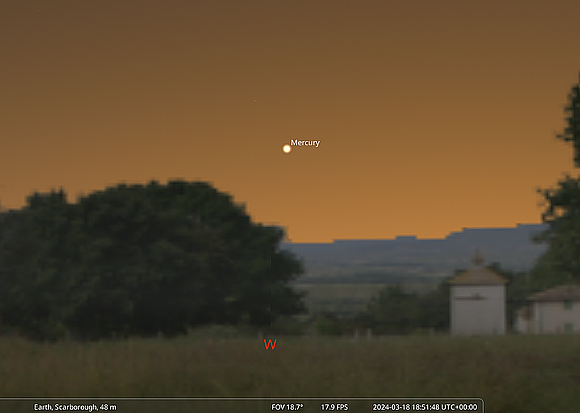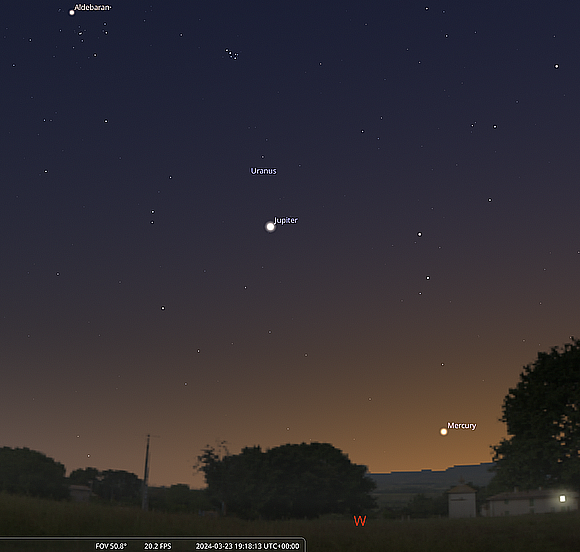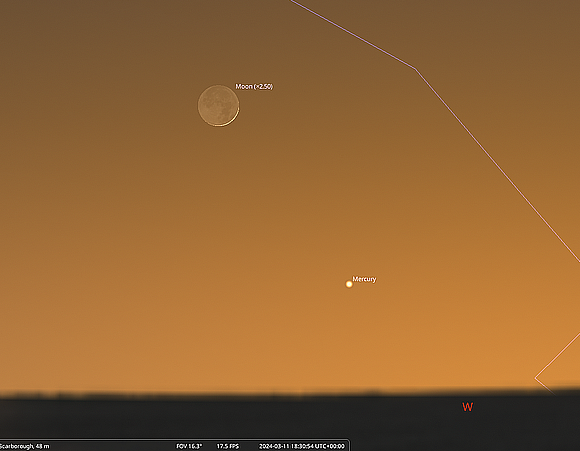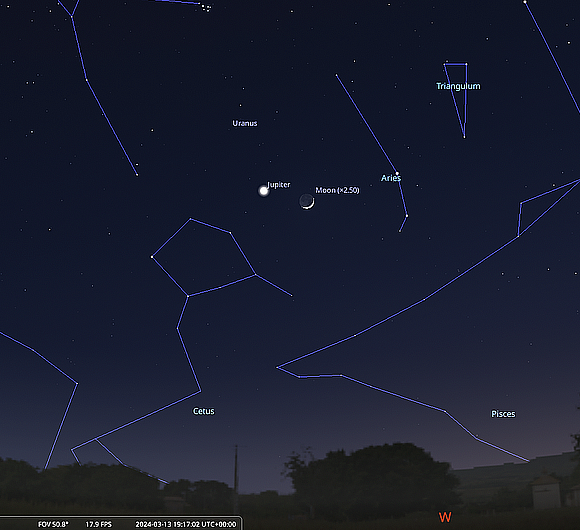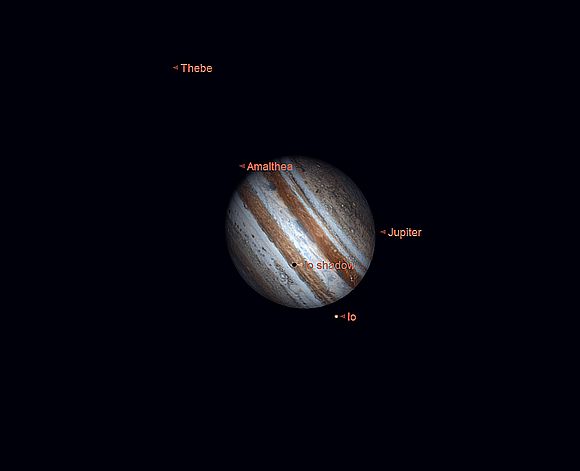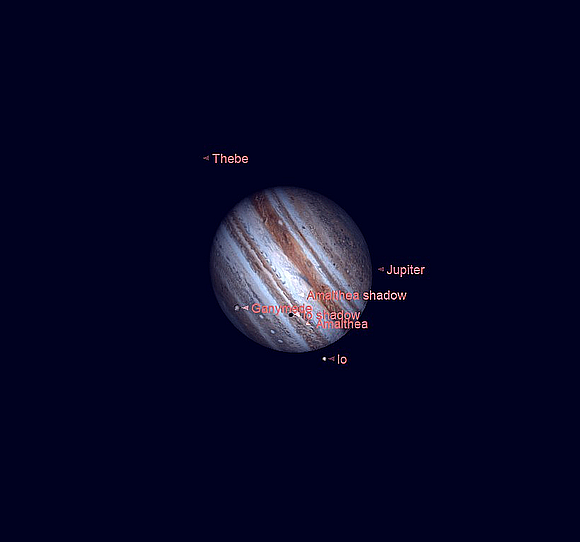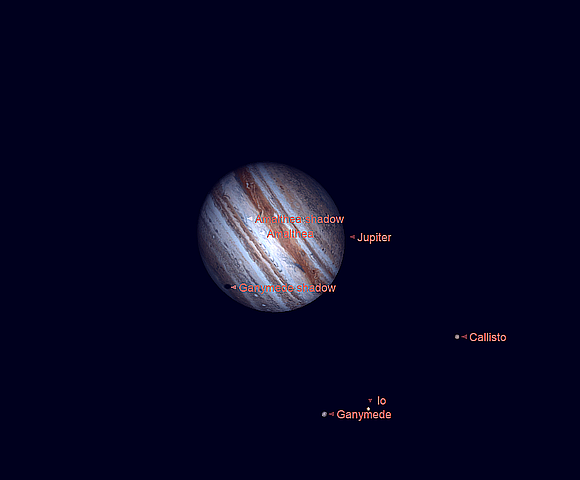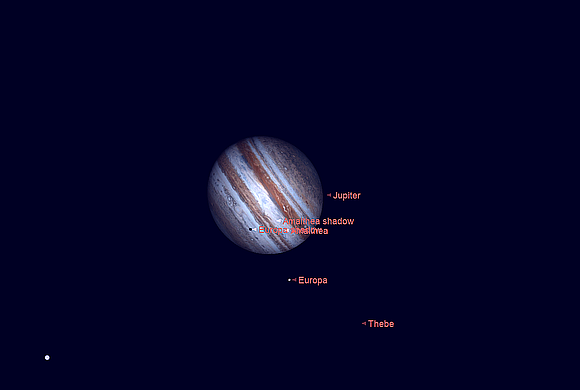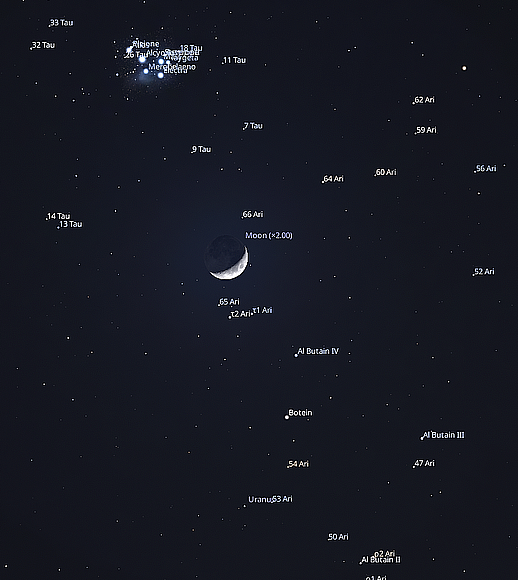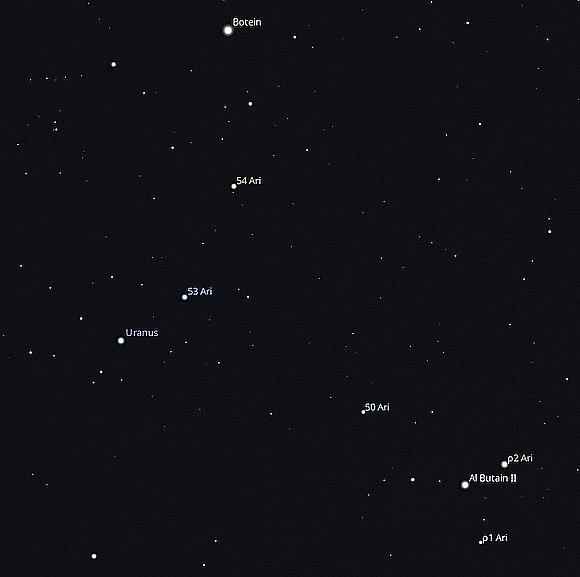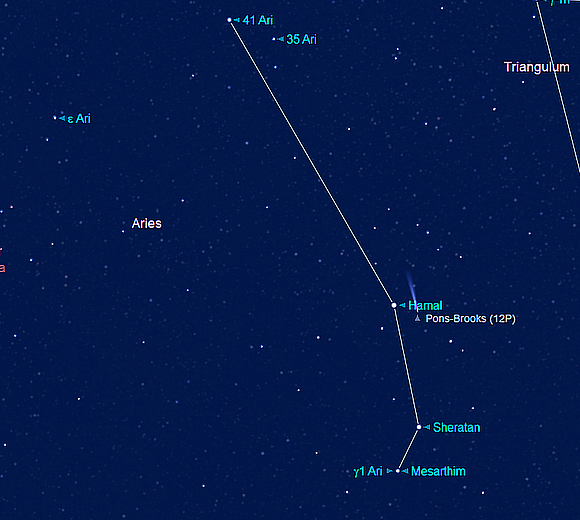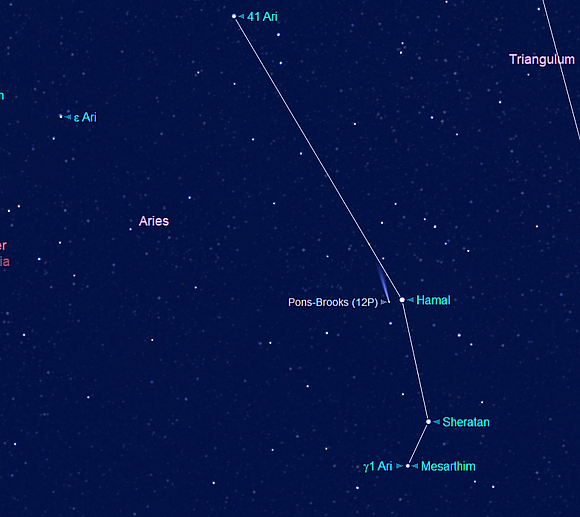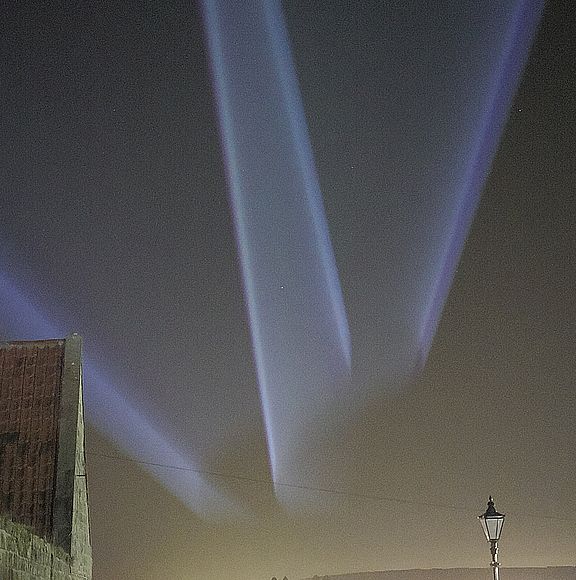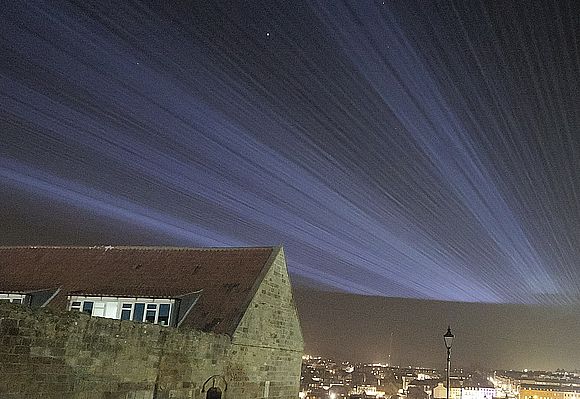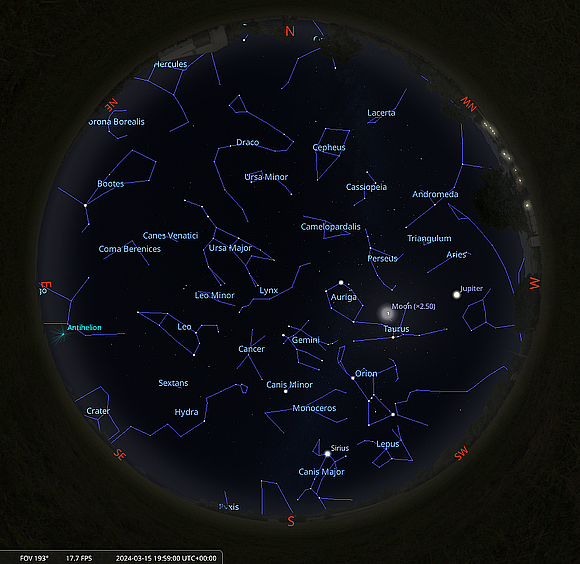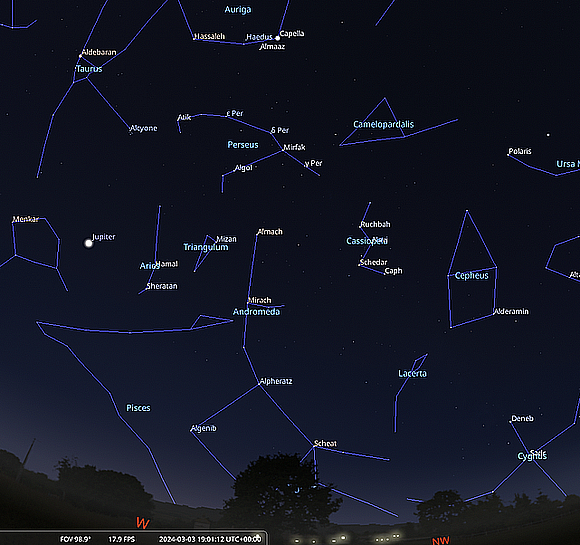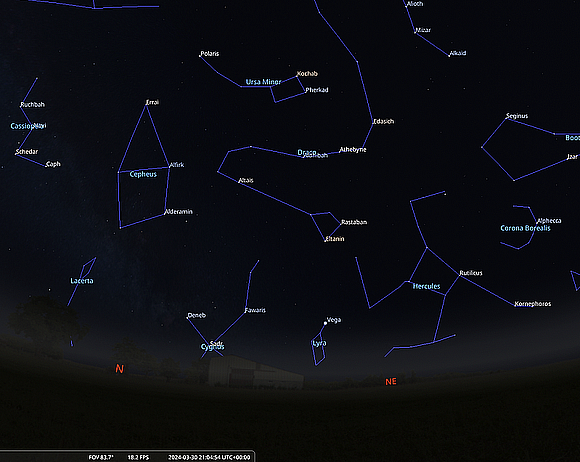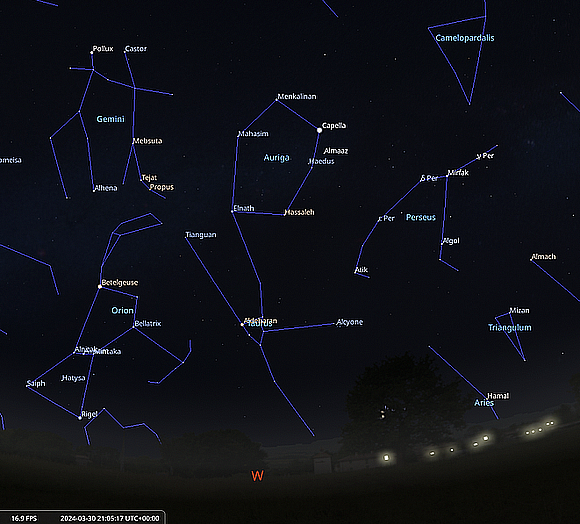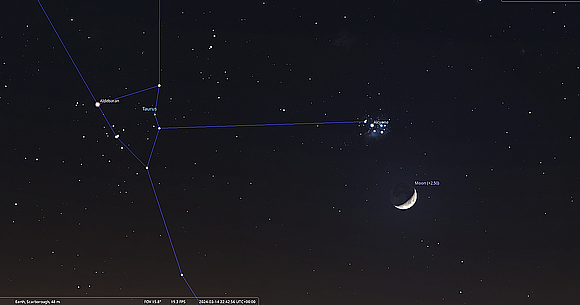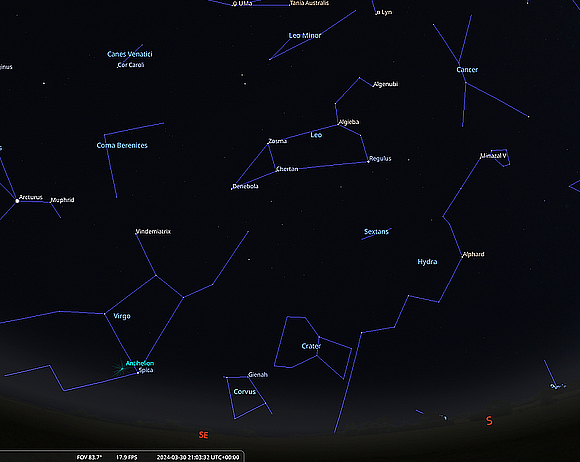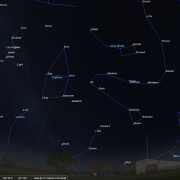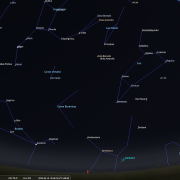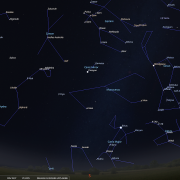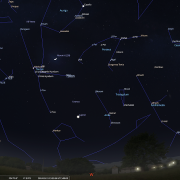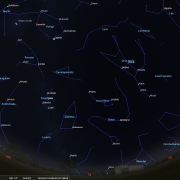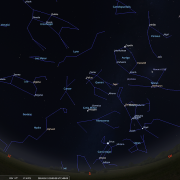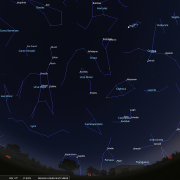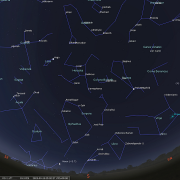In this month's Sky Notes:
- Planetary Skylights.
- March Meteors and Comet 12P/Pons-Brooks
- The Spring Eqinox.
- March night Sky.
- March 2024 Sky Charts.
Planetary Skylights - Brief
Jupiter sinks into west. Mercury pops up in the west. Uranus edges westward after Jupiter. Mars hides in the dawn twilight.
 Mercury returns to the evening sky during March emerging from the Sun's glare shortly before mid-month and may be spotted due West just above the West horizon around 18:35hrs GMT. This will be the most favourable evening apparition of Mercury in 2024 for UK observers. At the start of the apparition Mercury will be surprisingly bright at magnitude -1.3. It will however hug the west horizon, so to stand the best chance of observing the innermost world of the Sun's family you will require a flat, unobstructed western aspect. Mercury should be readily visible to naked eye, but if you are having difficulty use binoculars, scanning approximately 5 degrees above the horizon. Wait until 35 minutes after sunset.
Mercury returns to the evening sky during March emerging from the Sun's glare shortly before mid-month and may be spotted due West just above the West horizon around 18:35hrs GMT. This will be the most favourable evening apparition of Mercury in 2024 for UK observers. At the start of the apparition Mercury will be surprisingly bright at magnitude -1.3. It will however hug the west horizon, so to stand the best chance of observing the innermost world of the Sun's family you will require a flat, unobstructed western aspect. Mercury should be readily visible to naked eye, but if you are having difficulty use binoculars, scanning approximately 5 degrees above the horizon. Wait until 35 minutes after sunset.
Mercury pulls out to greatest eastern elongation of 19 degrees from the Sun by March 24th. It is still however just over 10 degrees in elevation above the horizon by the end of civil twilight, hence the need for an unobstructed horizon. By this date Mercury will have faded in brightness to mag -0.1, still a naked eye object. By the end of the month Mercury will have faded significantly to mag +1.4. Viewed through a telescope Mercury appears very small, showing little detail, apart from the phase, which being an inferior planet (inside Earth's orbit) changes over the course of its apparition. Mid-March the phase is 78% gibbous, reducing as the month progresses to a 43% crescent by the 24th, although the size of the phase will be a little larger than earlier in the apparition. Use medium - high magnifications to reveal this phase.
Very early in the apparition (March 11th) a young crescent Moon just a few days old sits above, left of Mercury, but you will need to view from 20 minutes after sunset scanning just above the due west horizon.
 As the current apparition of Jupiter draws to a close, March offers up the final opportunities to successfully scrutinise Jupiter through the eyepiece. Sliding down toward the NW horizon Jupiter’s observing window diminishes from 4 hours at the start, to less than 2 hours by the month's end when British Summer Time (BST) comes into force. Even so, at magnitude -1.9 Jupiter remains the brightest planetary presence in the evening sky, and viewed early in the month, and the evening, is still well placed for UK observers. Jupiter is then almost 40 degrees above the SW horizon as dusk falls, not setting until 23:00hrs. Gradually this creeps forward and by the third week in March Jupiter departs before 22:00hrs and by 21:30hrs just before BST commences on the 31st. by which time it is less than 21 degrees above the horizon as twilight deepens. A crescent Moon lies nearby Jupiter on March 13th.
As the current apparition of Jupiter draws to a close, March offers up the final opportunities to successfully scrutinise Jupiter through the eyepiece. Sliding down toward the NW horizon Jupiter’s observing window diminishes from 4 hours at the start, to less than 2 hours by the month's end when British Summer Time (BST) comes into force. Even so, at magnitude -1.9 Jupiter remains the brightest planetary presence in the evening sky, and viewed early in the month, and the evening, is still well placed for UK observers. Jupiter is then almost 40 degrees above the SW horizon as dusk falls, not setting until 23:00hrs. Gradually this creeps forward and by the third week in March Jupiter departs before 22:00hrs and by 21:30hrs just before BST commences on the 31st. by which time it is less than 21 degrees above the horizon as twilight deepens. A crescent Moon lies nearby Jupiter on March 13th.
For the first half of March Jupiter continues to be a fine spectacle in the eyepiece, thereafter 'seeing' will increasingly become an issue as Jupiter descends into the west. Look for the dark equatorial belts across the noticeably oblate disk, flanked by the Galilean moons. These are readily visible in instruments as small as 60mm (2.6”) aperture, mounted binoculars of similar aperture will also suffice. Larger instruments will reveal more detail including the great red spot feature, a colossal storm system, which over the last four decades appears to have diminished in size and hue intensity. The GRS can be observed in 100mm (4”) scopes but will be more obvious with 150mm (6”) instruments at medium powers. Optimum dates to seek out the GRS are March 3rd, 5th, 10th, 12th, 15th, 17th, 22nd, 24th, 27th and 29th between 19:00hrs and 20:30hrs GMT.
The ever-changing nightly configuration of the Galilean moons orbiting around Jupiter is always of interest to the observer, and when visible the phenomena of shadow transits (seen as a black dot) caused by Io, Europa, Ganymede, and Callisto, are particularly fascinating to track across the disk of Jupiter. The most favourable shadow transits in March are Io - March 2nd @ 19:30hrs & 25th @ 20:00hrs. Europa - March 28th @ 20:00hrs. Ganymede - March 18th @ 19:45hrs GMT. A 100mm aperture using high power will suffice to spot these, although 150mm (6") would be more suitable.
 Uranus remains a viable observational target throughout March, and like Jupiter becomes more challenging by the end of the month as it drops closer to the horizon and the observing 'dark sky' window diminishes. Located between Jupiter and the Pleiades star cluster, at magnitude +5.8 Uranus is technically visible to the naked eye, but very dark, transparent skies are required to achieve this. An aperture of 75-80mm (3") at high power can reveal the tiny 3.5-degree disk, soft green/grey in hue, whilst apertures above this should clearly show it.
Uranus remains a viable observational target throughout March, and like Jupiter becomes more challenging by the end of the month as it drops closer to the horizon and the observing 'dark sky' window diminishes. Located between Jupiter and the Pleiades star cluster, at magnitude +5.8 Uranus is technically visible to the naked eye, but very dark, transparent skies are required to achieve this. An aperture of 75-80mm (3") at high power can reveal the tiny 3.5-degree disk, soft green/grey in hue, whilst apertures above this should clearly show it.
Uranus currently resides in the lower reaches of Aries, above the 'head' of Cetus, but close to the Taurus/Aries border. It can be located some 45 degrees above the SW horizon as dusk falls at the start of March. There are no obvious stars nearby - the 4th magnitude Delta Ari (Botein) an orange 'K type' star lies just 2 degrees above Uranus, with fainter 53 Ari the closest star. A waxing crescent Moon sits midway between Uranus and the Pleiades on March 14th.
March Meteors and Comet Activity
March continues where February left off with no recognised meteor showers of note. Even though it is a lean period for shooting stars, those that are spotted are often quite bright and it has been suggested that late January to early March; the 'fireball' season', may be a very old, depleted shower of similar nature to the Geminids. Towards the end of March there are signs of activity from the various and complex Virginid radiants, but numbers remain low with 'peak activity' not reached until April. The two main radiants lie near Spica and Kappa Virginis, but typically just a few meteors per hour are recorded by an observer. True Virginids are often slow moving and long in duration, occasionally very bright (Jupiter brightness) producing flares along their path. As usual early morning hours will be most favourable.
Comet 12P/Pons-Brooks
This 'Halley like' short period comet is certainly one to follow having had several major outbursts already. The one on November 13th being the most dramatic when the comet brightened from mag +13 to mag +9. Pons-Brooks has an orbital period of 71 years and is the probable parent body causing the κ-Draconids meteor shower. First discovered by Jean-Louis Pons in 1812, it was then independently rediscovered by William Robert Brooks in 1883.
At perihelion on April 21st (closest passage to the Sun) the comet comes within about 0.78 astronomical units (AU) of it and should then be at its brightest. That is just a couple of weeks after the Total solar eclipse that will cross North America on April 8th and as Comet 12/P will be in the same part of the sky as the eclipsed Sun on the 8th, it is interesting to speculate whether the comet will be visible to the naked eye.
But that is next month. This month you can locate the comet in southern Andromeda at the start of March, 2.5 degrees north-east of 73 Pegasi. It then tracks south-eastwards through Andromeda and Pisces, ending the month just half a degree south-east of Hamal - chief star in Aries. As twilight deepens around 20:00hrs BST, the comet will lie 22 degrees above the west horizon. By then Pons-Brooks may be just visible to the naked eye but should have brightened enough to be picked up in binoculars at least. More next month.
Finally, did anyone else notice the crazy celestial phenomenon visible over Whitby - end of February, start of March. Display of Aurora? Brilliant comet? Can't understand why the media never picked up on it? See below.
The Spring Equinox

Spring bursts forth! Hole of Horcum - North York Moors. Image - M Dawson
The date of the Spring or Vernal Equinox marks the start of astronomical spring in the northern hemisphere falls on March 20th this year. The Vernal Equinox marks a moment, not an entire day, that moment being when the Sun's path on the ecliptic first crosses the celestial equator on its apparent journey northwards into the sky (for the N hemisphere). The orientation of the Earth at the spring or autumnal equinox is such that neither of Earth’s poles is inclined toward the Sun and all locations experience equal hours of daylight and darkness - hence the term equinox, derived from Latin meaning equal night. It is however not true that both day and night are exactly 12 hours long, on this date as daylight is still slightly longer. The actual date of equal daylight and darkness is called the equilux and falls a few days before the spring equinox.
As Spring starts, the length of day increases dramatically in most regions, except for the tropics, where day lengths do not change much during the course of a year. In fact, the increase is greatest in the days surrounding the spring equinox. After that, days still get longer, but at an ever-decreasing rate. On the longest day of the year, the Summer solstice, this day-to-day difference reaches zero. Locations farther from the equator experience larger day-to-day differences. In Whitby the day of the spring equinox is 3 minutes longer than the previous day; whereas in Athens around 2000 kilometers or 1200 miles farther south, the difference is only around 90 seconds. The Vernal Equinox is also known as the 'First point of Aries', as the Sun used to stand before the constellation of the Ram when it first crossed the celestial equator. Although still called the 'first point of Aries', today its location now resides in Pisces, a consequence of the effect known as precession; the Earth's slow wobble.
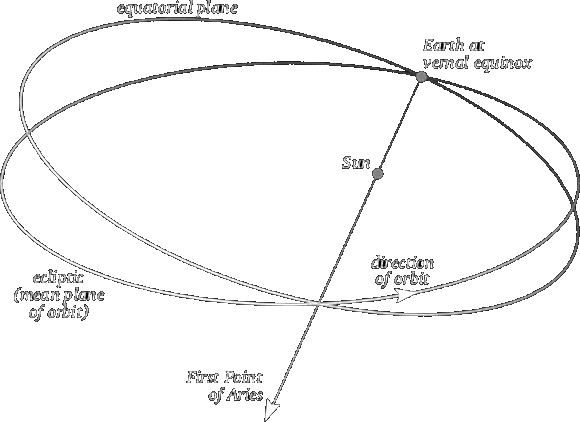 Over thousands of years our ancestors noted that certain star patterns rose just before the Sun at specific times and were considered significant for this very reason. Subsequently they were able to build a picture of the apparent path of the Sun against these constellations. The narrow path upon which occasionally the Sun and Moon would meet giving rise to an eclipse, became known as the Ecliptic. The broader belt along which the 'wandering stars' or planets travelled was known as the Zodiac, so called because all 12 constellations located on it were associated with living creatures. The zodiac constellations extend about 8° north and south of the ecliptic. The signs of the zodiac have origins dating back as far as Babylonian astronomy around 1500 BC, which we know as astrology today. It was also the Babylonians that decided to have 12 zodiac signs, leaving out Ophiuchus.
Over thousands of years our ancestors noted that certain star patterns rose just before the Sun at specific times and were considered significant for this very reason. Subsequently they were able to build a picture of the apparent path of the Sun against these constellations. The narrow path upon which occasionally the Sun and Moon would meet giving rise to an eclipse, became known as the Ecliptic. The broader belt along which the 'wandering stars' or planets travelled was known as the Zodiac, so called because all 12 constellations located on it were associated with living creatures. The zodiac constellations extend about 8° north and south of the ecliptic. The signs of the zodiac have origins dating back as far as Babylonian astronomy around 1500 BC, which we know as astrology today. It was also the Babylonians that decided to have 12 zodiac signs, leaving out Ophiuchus.

The Ecliptic and Zodiac constellations arranged around the celestial sphere.
Zodiac literally means 'circle of little animals'. Libra used to be considered being part of Scopius, the claws to be precise. Ophiuchus, the serpent bearer immediately following Scorpius was instead regarded as a zodiac group. Ever since the stars of Libra were elevated in status, Ophiuchus, being surplus to requirements, was ditched, much to the relief of astrologers. If you find it difficult to remember the order of the zodiac constellations, then the following rhyme may be of use.
The Ram, the Bull, the Heavenly twins
and next the Crab the Lion shines,
The Virgin, and the Scales.
Scorpion, Archer and Sea goat,
The man who pours the water out
and Fish with glittering tails.
March Night Sky
Of all the months in the year, March is undoubtedly regarded as the month of change in the Northern Hemisphere. Not only does March contain the first days of Spring, (meteorological - March 1st, and Astronomical - March 21st), the latter date is also the date of the Vernal or Spring Equinox. Furthermore, in the UK, it's the month in which clocks go forward 1 hour as BST ((British Summer Time) comes into operation and thoughts turn misguidedly - on overly warm March days, toward Summer, let alone spring. A cruel joke perpetrated by mother nature as days following BST are often bleak, cold, wet...and sometimes even - white! It is not uncommon to find snow on the doorstep. It is the month when 'Lions' can roar', 'Lambs bleat' and 'beasts from the east' wreak havoc with flora and fauna, falsely enticed out early during the obligatory February heat wave! March then can be a 'very odd' month weather-wise.
When it comes to observing the night sky, March is however often considered by amateur astronomers as being the crème de la crème of observing windows. Hours of darkness exceed daylight hours until the 3rd week of the month, and evenings can be conducive to spend time under as we reach the Vernal or Spring equinox. Earth then, is ideally positioned in its orbit around the Sun and the opportunity arises to view constellations associated with all four seasons over the course of one night, together with the wide variety of deep sky objects located within them. If moonlight is absent, there is also the possibility to undertake a celestial marathon!
The gradual shift of the March sky will not be upset until the very last day of the month following the arrival of BST. Before then, if you view early in March some Autumnal constellations are reasonably placed for observation. In the WNW you will locate the Great Square of Pegasus with the stars of Andromeda reaching up from the horizon toward the figures of Perseus and Cassiopeia flanking the Zenith directly overhead. Circumpolar summer stars are banished to the celestial margins low to the north - as Vega and Deneb in Lyra and Cygnus respectively, flirt with the horizon.
The familiar Plough (or big dipper) asterism in Ursa Major, stands on its tail to the NE, the 'pointer stars' - Dubhe and Merek, in the rear of the bowl utilised to identify Polaris - the Pole star, in Ursa Minor. The Celestial dragon, Draco winds its way between the two bears, the head of the beast marked by an irregular quadrilateral of stars resides due North not far from Vega.
Overhead the distinctive ‘W’ pattern of Queen Cassiopeia first occupies the zenith, followed by Perseus the outline of which resemble a distorted figure Pi symbol) and then the stars of Auriga the charioteer, highlighted by brilliant Capella, classed as a circumpolar winter star from these shores.
High to the SW the 'V' pattern of the Hyades star cluster, marking the head of Taurus, point down to the NW horizon. Masquerading as a true member, the marmalade hue of conspicuous Aldebaran, 'the eye of the bull', marking the southern tip of the cluster, resides at half the distance of genuine cluster members some 65 lights years further away. To the west of the Hyades, the beautiful Pleiades star cluster or Seven Sisters, continue to flee from the unwanted advances of Orion - the mighty hunter, marching into the western half of the sky, accompanied by the sparkling tableau of winter.
Orion is identified by the three belt stars, as well as the first magnitude luminaries, Rigel and Betelgeuse, stars at opposite ends of their lives, but both destined to go supernova. Betelgeuse - a red supergiant, has already one foot in the grave, perhaps thousands of years hence, whereas white Rigel still has millions of years, still a blink of the cosmic eye!
Beneath the belt stars resides one of the great showpiece objects in the night sky, the Orion nebula, a region of stellar birth around 1300 light years away and perhaps only 2.4 million years old. This stellar nursery consists of a huge cloud of gas and dust 25-35 light years in extent, within which star formation is underway. Indeed, it is richest star cluster known of within our galactic neighbourhood, although most of the stars are hidden. The nebula is seen clearly as a misty smudge through smaller binoculars but can be a breathtaking sight when observed through a telescope. Look for the Trapezium star cluster, the four 'bully boys' of this stellar crèche, seen easily in the smallest of telescopes.
The two hunting dogs of Orion, Canis Major, and Canis Minor, dutifully follow their master across the heavens. The belt stars of Orion point down in the general direction of Canis Major and the most prominent of all night stars, sparkling Sirius, visible due south as darkness falls. Above and left, solitary Procyon, in the lesser dog of Canis Minor, is yet another conspicuous winter jewel. The prominence of both stars is primarily due to proximity; 8.6 and 11 light years respectively. Strangely both stars also have companion white dwarf stars, although they are very difficult to spot even with quite large instruments, being near their primary star.
Look for the faint glow of the Winter Milky Way which flows up beside Orion, separating the two dogs on opposing banks. The dogs' quarry is perhaps the celestial hare of Lepus, timidly crouching below the feet of Orion, just above the SSW horizon. Within the faint starry haze left of Orion, a more modern constellation is located, the Unicorn of Monoceros. Its stars are faint and to the naked eye the area looks bland at first glance but hidden just beyond our gaze reside a multitude of star clusters and nebulae. Below the Unicorn, Puppis, part of the now defunct constellation of Argo Navis straddles the S horizon. It too is rich in galactic clusters and nebulae, including the Messier objects M46, M47 and M93.
The longest constellation in the heavens, Eridanus (or at least a section of it) occupies much of the sky lower right of Orion. The river Eridanus, the source of which starts close by Rigel, is marked by Cursa (beta Eridani) then flows erratically parallel to the southern horizon before plunging through it, journeying far down into the southern hemisphere, ending at a brilliant star called Archenar.
Upper left of Orion stand the Twins of Gemini, highlighted by the two stars, Castor, and Pollux. Castor, the most northerly of the pair, is slightly fainter than twin brother Pollux which shines with a pale amber lustre. Although Castor appears solitary to the naked eye and in binoculars, it is in fact a sextuplet system of which the brightest two components may be separated in modest scopes - given stable atmospheric conditions.
March 14th, 2024 - late evening. Crescent Moon, Pleiades and Hyades star clusters.
(Click for full image)
As March progresses, winter groups slip down, westwards, increasingly supplanted by an ensemble of spring constellations taking to the celestial stage. The inconspicuous stars of Cancer scuttle after Gemini and mark the border of seasonal change. Cancer may be faint but contains the fine open cluster M44 - the Beehive or Praecipe. The signature group of spring: - Leo the Lion follows, identified by the distinctive ‘Sickle’ asterism, at the foot of which sits bright Regulus, residing almost on the ecliptic.
Ahead of Regulus and below Procyon, a faint, yet distinctive 'knot' of stars marks the head of Hydra, the largest constellation by area in the night sky. The Water Snake's isolated chief star, Alphard - the 'Lonely one', resides a little way below this head and is identified by its amber hue and relative brightness. The clock is ticking toward midnight before the whole of Hydra slithers fully into view toward the month's end accompanied by two constellations resting on its coils: Crater the Cup and Corvus the Crow.
Late March - just before introduction of BST, viewing south/southeast @ 21:00hrs GMT.
(Click for full image)
Rising in the east look for the brilliant amber hue of Arcturus in Boötes the Herdsman. It is the second brightest star visible from the UK after Sirius, its soft orange lustre in marked contrast to the sparkling diamond of the Dog star. By the end of March, Spica - chief star in Virgo, returns to our skies after being exiled below the horizon for almost 6 months, the Sower of crops joining the victims of Hercules, pushing the stars associated with the long, dark, nights of winter out of Earth's door, as spring proper takes root in the night sky.
The Messier Marathon
If night skies are clear during the latter half of March, especially around the Spring equinox, astronomers’ thoughts may turn to attempting an observing challenge, a race against time, a marathon - the Messier marathon in fact. This entails identifying as many of the objects catalogued by the famous French astronomer, the greatest discovery of comets in the middle of the 18th century, between sunset and sunrise the following morning. Attempted by many amateur astronomers in the northern hemisphere, few complete the challenge, and from UK latitudes, mid-northern Europe, it is actually not possible to do so, but the observer can still strive to achieve personal bests.
Over the intervening years the Messier catalogue has been revised several times and in its current form 110 objects are listed. Entries include galaxies, star clusters, nebulae and the catalyst for his work, the supernova remnant - the Crab Nebula in Taurus – M1. (Messier would be unaware of its nature). For example, the great nebula in Orion is also known as M42; the Pleiades M45, the Andromeda galaxy as M31, the Ring nebula M57 etc.
At least a score of Messier objects may be seen on any clear night, but because of their distribution in the sky, early spring is especially suited for observing. Galaxies and open star clusters are found in abundance throughout the winter/spring constellations visible during the first part of the night, whilst globular clusters and many nebulae associated with summer skies are visible before dawn. This is how the idea of the Messier Marathon arose, observing as many entries as possible in an all-night endurance race before the Sun rises. A humble pair of binoculars are sufficient to show a good number of objects, some are visible to the naked eye alone. All the entries are within grasp of a 120mm reflector or refractor telescope, so armed with modest equipment, a sky chart or App, and a little knowledge of the night sky, even a novice can bag around three dozen objects without burning the midnight oil.
Having said all this, 2024 poses a problem with the Moon apparent in the sky for the latter part of March, and light pollution (natural or otherwise) will simply drown out many deep sky objects. It is still possible to achieve good numbers following the introduction of BST at the end of March by which time the Moon is waning, but by the second week in April be aware that the dark observing window has diminished considerably. Bad timing all round this year!
March 2024 Sky Charts
Additional Image Credits:
- Sky charts/Sky chart images credits: Stellarium and Starry Night Pro Plus 8
- Log in to post comments

